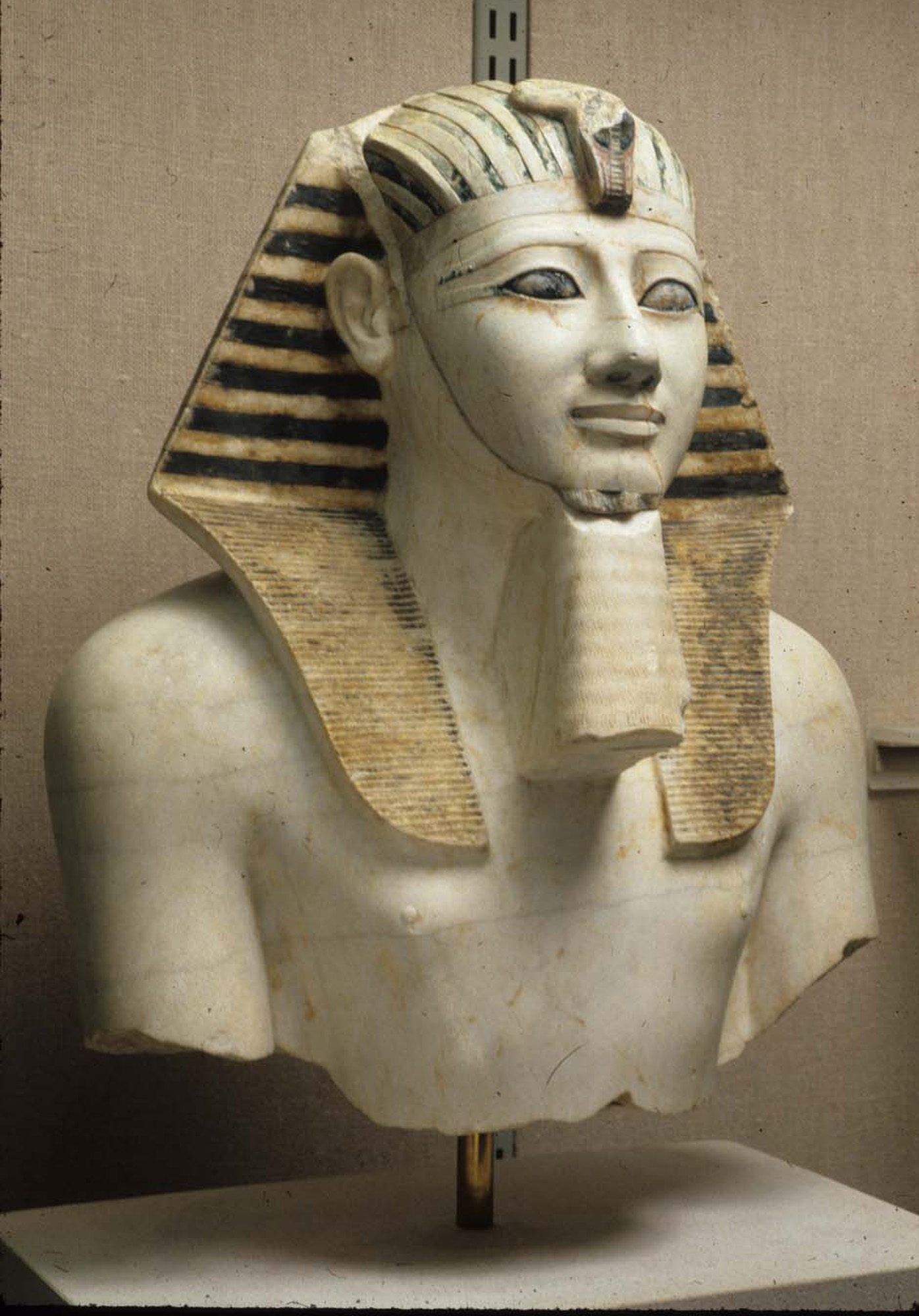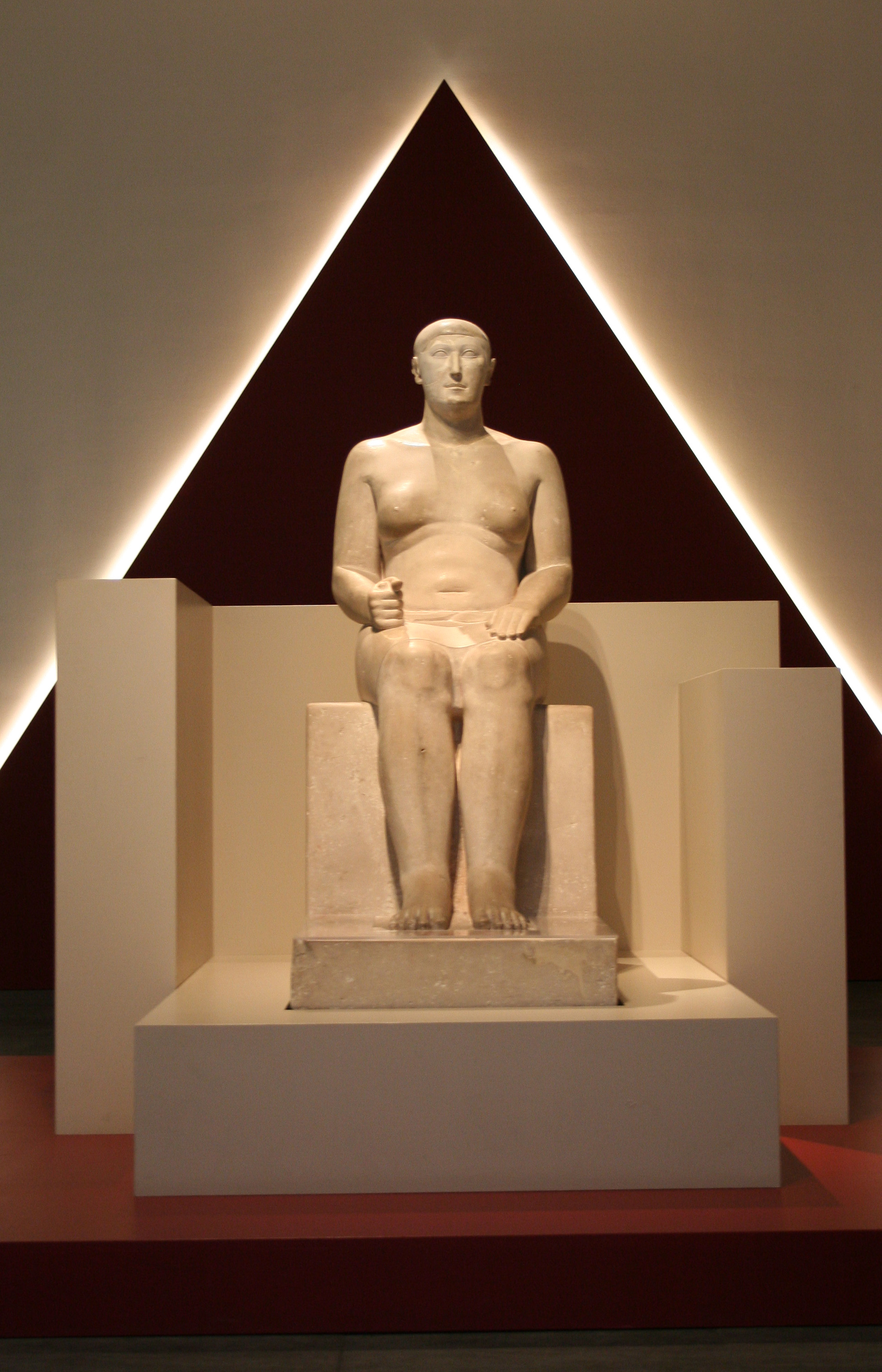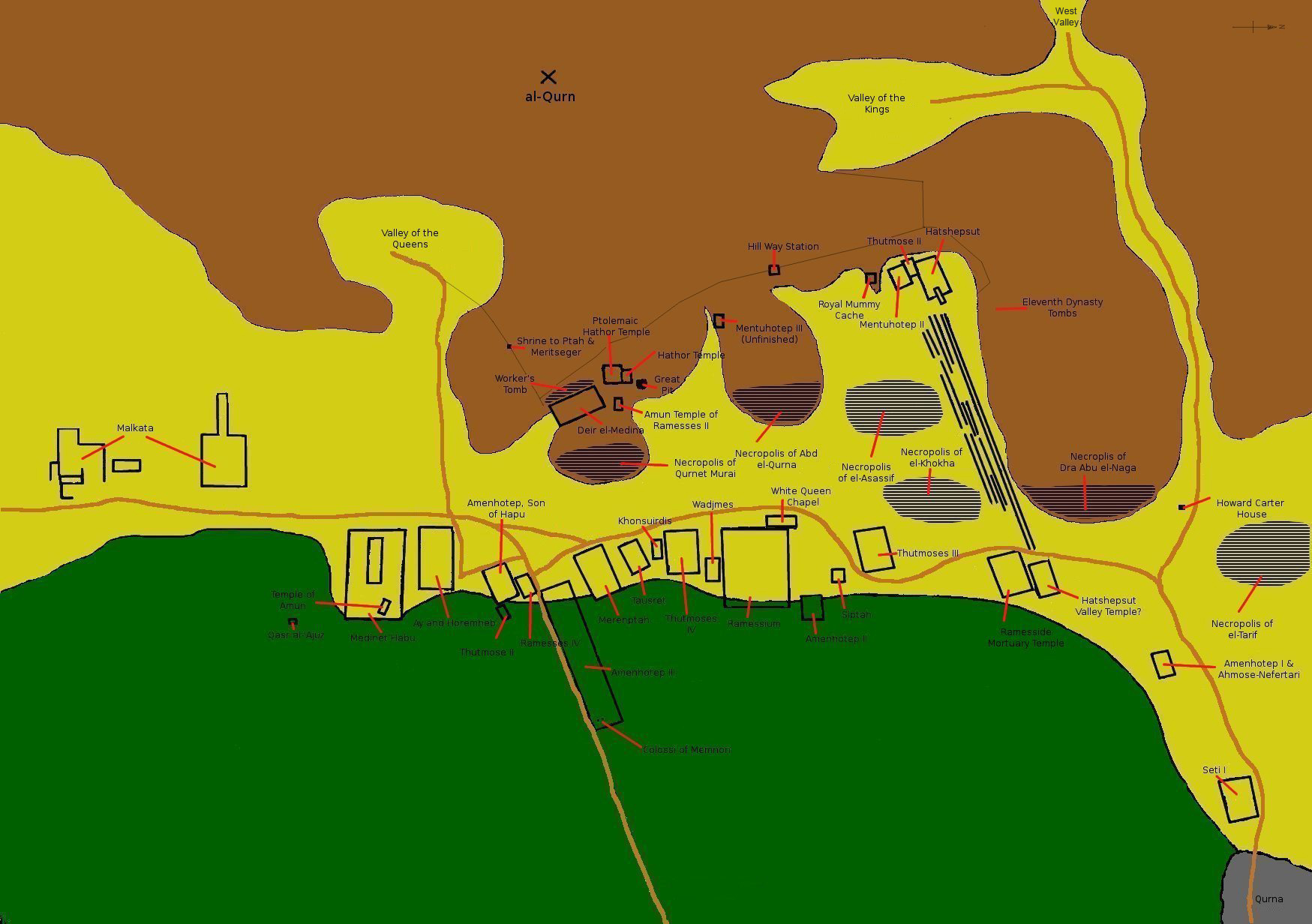|
Rekhmire
Rekhmire was an ancient Egyptian noble and official of the 18th Dynasty who served as "Governor of the Town" ( Thebes) and Vizier during the reigns of Thutmosis III and Amenhotep II, circa 1400 BCE. He was the nephew of Vizier User, who took office at the time of the fifth year of Queen Hatshepsut’s reign. User's official titles included mayor of the city, vizier, and prince. Rekhmire is noted for constructing a lavishly decorated tomb for himself in Sheikh Abd el-Qurna, part of the Theban Necropolis, containing lively, well preserved scenes of daily life during the Egyptian New Kingdom. His tomb is also important as it contains a full copy of a text detailing the duties of the office of the vizier, known as the Installation of the Vizier. He was also High Priest of Annu Heliopolis (I͗wnw, Iunu or 𓉺𓏌𓊖; egy, I͗wnw, 'the Pillars'; cop, ⲱⲛ; gr, Ἡλιούπολις, Hēlioúpοlis, City of the Sun) was a major city of ancient Egypt. It was the capital of ... [...More Info...] [...Related Items...] OR: [Wikipedia] [Google] [Baidu] |
TT100
The Theban Tomb TT100 is located in Sheikh Abd el-Qurna, part of the Theban Necropolis, on the west bank of the Nile, opposite to Luxor. It is the mortuary chapel of the ancient Egyptian vizier Rekhmire. There is no burial chamber next to this chapel. The vizier's tomb is elsewhere, perhaps even in the Valley of the Kings. The tomb Hall Using the labeling in Porter and Moss, there are eleven scenes or combinations of scenes inscribed in the hall of TT100. # The lintel and jambs of the entry into the hall show offering scenes. # Rekhmire inspects officials and other individuals. The duties of a vizier are recorded in the text. Further scenes show tax collection. # Autobiographical text # Rekhmire and attendants record foreign tribute including Keftiu offer decorative vases, Nubians are depicted with animals such as leopards, giraffe, cattle and more, the Syrians offer tribute including chariots, horses, a bear and an elephant. # Rekhmire's installation as vizier befo ... [...More Info...] [...Related Items...] OR: [Wikipedia] [Google] [Baidu] |
Retjenu
Retjenu ('' rṯnw; Reṯenu, Retenu''), was an ancient Egyptian name for Canaan and Syria. It covered the region from the Negev Desert north to the Orontes River. The borders of Retjenu shifted with time, but it generally consisted of three regions. The southernmost was Djahy, which had about the same boundaries as Canaan.Steindorff, George. ''When Egypt Ruled the East.'' p. 47. University of Chicago Press, 1942. Lebanon proper was located in the middle, between the Mediterranean and the Orontes River. North of Lebanon was designated Amurru, the land of the Amorites. Occurrences of the term Overall, numerous mentions of the Retjenu appear in Egyptian inscriptions. 12th Dynasty The earliest attestation of the name occurs in the Sebek-khu Stele, dated to the reign of Senusret III (reign: 1878–1839 BCE), recording the earliest known Egyptian military campaign in the Levant and their victory over the Retjenu: "His Majesty proceeded northward to overthrow the Asiatics. His Maj ... [...More Info...] [...Related Items...] OR: [Wikipedia] [Google] [Baidu] |
Installation Of The Vizier
The Installation of the vizier, alt. Instruction of Rekhmire, Regulation laid upon the vizier Rekhmire, is an ancient Egyptian text dating to the New Kingdom found in Rekhmire's tomb at Thebes. It describes the office of the Egyptian vizier, his appointment, his duties, his relationships to other officials, and how to behave. Two incomplete copies of the ''Regulation laid upon the vizier Rekhmire'' have survived, one in the tomb of Useramen (reign of Thutmose III) and another in the tomb of Amenemope (reign of Amenhotep II. The vizier's main functions according to the ''Regulation'' are in the fields of the judiciary, treasury, war, interior Interior may refer to: Arts and media * ''Interior'' (Degas) (also known as ''The Rape''), painting by Edgar Degas * ''Interior'' (play), 1895 play by Belgian playwright Maurice Maeterlinck * ''The Interior'' (novel), by Lisa See * Interior de ..., agriculture, and general executive.Breasted, ''op.cit.''§ 672/ref> References ... [...More Info...] [...Related Items...] OR: [Wikipedia] [Google] [Baidu] |
Thutmose III
Thutmose III (variously also spelt Tuthmosis or Thothmes), sometimes called Thutmose the Great, was the sixth pharaoh of the Eighteenth Dynasty. Officially, Thutmose III ruled Egypt for almost 54 years and his reign is usually dated from 28 April 1479 BC to 11 March 1425 BC, from the age of two and until his death at age fifty-six; however, during the first 22 years of his reign, he was coregent with his stepmother and aunt, Hatshepsut, who was named the pharaoh. While he was shown first on surviving monuments, both were assigned the usual royal names and insignia and neither is given any obvious seniority over the other. Thutmose served as the head of Hatshepsut's armies. During the final two years of his reign, he appointed his son and successor, Amenhotep II, as his junior co-regent. His firstborn son and heir to the throne, Amenemhat, predeceased Thutmose III. He would become one of the most powerful pharaohs of the 18th dynasty. Becoming the sole ruling pharaoh of the ... [...More Info...] [...Related Items...] OR: [Wikipedia] [Google] [Baidu] |
Vizier (Ancient Egypt)
The vizier () was the highest official in ancient Egypt to serve the pharaoh (king) during the Old, Middle, and New Kingdoms. Vizier is the generally accepted rendering of ancient Egyptian , etc., among Egyptologists. The ''Instruction of Rekhmire'' (''Installation of the Vizier''), a New Kingdom text, defines many of the duties of the , and lays down codes of behavior. The viziers were often appointed by the pharaoh. During the 4th Dynasty and early 5th Dynasty, viziers were exclusively drawn from the royal family; from the period around the reign of Neferirkare Kakai onwards, they were chosen according to loyalty and talent or inherited the position from their fathers. Responsibilities The viziers were appointed by the pharaohs and often belonged to a pharaoh's family. The vizier's paramount duty was to supervise the running of the country, much like a prime minister. At times this included small details such as sampling the city's water supply. All other lesser supervisor ... [...More Info...] [...Related Items...] OR: [Wikipedia] [Google] [Baidu] |
Useramen
Useramen (also called User, Amenuser, or Useramun) was an ancient Egyptian vizier under pharaohs Hatshepsut and Thutmose III of the 18th Dynasty. Family Useramen was the son of the vizier Amethu called Ahmose, who served during the reign of Thutmose II and the early years of the combined reigns of Hatshepsut and Thutmose III.Hatshepsut by Anneke Bart His mother's name was Ta-amenthu. Useramen was married to a lady named Tuiu, and the couple is known from their tombs to have had at least four daughters and a son.Porter,B. and Moss R.L.B., Topographical Bibliography of Ancient Egyptian Hieroglyphic Texts, Reliefs and Paintings: The Theban Necropolis, Part One: Private Tombs. Second Edition. Griffith Institute. Oxford. 1994 Useramen came from a very influential family. His father was ... [...More Info...] [...Related Items...] OR: [Wikipedia] [Google] [Baidu] |
Sheikh Abd El-Qurna
The necropolis of Sheikh Abd el-Qurna ( ar, شيخ عبدالقرنة) is located on the West Bank at Thebes in Upper Egypt. It is part of the archaeological area of Deir el-Bahari, and named after the domed tomb of the local saint. This is the most frequently visited cemetery on the Theban west bank, with the largest concentration of private tombs. Tombs * TT21 User, Scribe, Steward of king Thutmose I * TT22 Wah, later usurped by Meryamun * TT23 – Tjay * TT30 Khonsmose, Amun treasury official, Ramesside * TT31 – Khonsu * TT38 Djeserkaraseneb, Scribe, Counter of grain in the granary of the divine offerings of Amun * TT41 Amenemopet called Ipy, Amun temple high steward * TT42 Amenmose, Captain of troops, Eyes of the King in the Two Lands of the Retenu * TT43 Neferrenpet, Overseer of the kitchen (stores?) of Pharaoh * TT44 Amenemhab, wab-priest in front of Amun * TT45 Djehuty, Steward of high priest of Amun Mery * TT46 Ramose, Steward of the Mansion of the Ate ... [...More Info...] [...Related Items...] OR: [Wikipedia] [Google] [Baidu] |
Annu
Heliopolis (I͗wnw, Iunu or 𓉺𓏌𓊖; egy, I͗wnw, 'the Pillars'; cop, ⲱⲛ; gr, Ἡλιούπολις, Hēlioúpοlis, City of the Sun) was a major city of ancient Egypt. It was the capital of the 13th or Heliopolite Nome of Lower Egypt and a major religious centre. It is now located in Ayn Shams, a northeastern suburb of Cairo. Heliopolis was one of the oldest cities of ancient Egypt, occupied since the Predynastic Period.. It greatly expanded under the Old and Middle Kingdoms but is today mostly destroyed, its temples and other buildings having been scavenged for the construction of medieval Cairo. Most information about the ancient city comes from surviving records. The major surviving remnant of Heliopolis is the obelisk of the Temple of Ra-Atum erected by Senusret I of Dynasty XII. It still stands in its original position, now within Al-Masalla in Al-Matariyyah, Cairo. The high red granite obelisk weighs 120 tons (240,000 lbs) and is believed to be the ... [...More Info...] [...Related Items...] OR: [Wikipedia] [Google] [Baidu] |
High Priest
The term "high priest" usually refers either to an individual who holds the office of ruler-priest, or to one who is the head of a religious caste. Ancient Egypt In ancient Egypt, a high priest was the chief priest of any of the many gods revered by the Egyptians. * While not regarded as a dynasty, the High Priest of Amun at Thebes, Egypt were nevertheless of such power and influence that they were effectively the rulers of Upper Egypt from 1080 to c. 943 BCE * High Priest of Osiris. The main cult of Osiris was in Abydos, Egypt. * High Priest of Ptah. The main cult of Ptah was in Memphis, Egypt. * High Priest of Ra. The main cult of Ra was in Heliopolis (ancient Egypt). * God's Wife of Amun the highest ranking priestess of the Amun cult. Ancient Israel The High Priest of Israel served in the Tabernacle, then in the Solomon's Temple and the Second Temple in Jerusalem. The Samaritan High Priest is the high priest of the Samaritans. Ancient world * Archiereus, title of ... [...More Info...] [...Related Items...] OR: [Wikipedia] [Google] [Baidu] |
New Kingdom Of Egypt
The New Kingdom, also referred to as the Egyptian Empire, is the period in ancient Egyptian history between the sixteenth century BC and the eleventh century BC, covering the Eighteenth, Nineteenth, and Twentieth dynasties of Egypt. Radiocarbon dating places the beginning of the New Kingdom between 1570 BC and 1544 BC. The New Kingdom followed the Second Intermediate Period and was succeeded by the Third Intermediate Period. It was Egypt's most prosperous time and marked the peak of its power. The concept of a "New Kingdom" as one of three "golden ages" was coined in 1845 by German Egyptologist Baron von Bunsen, and its definition would evolve significantly throughout the nineteenth and twentieth centuries. The later part of this period, under the Nineteenth and Twentieth dynasties (1292–1069 BC), is also known as the ''Ramesside period''. It is named after the eleven pharaohs who took the name Ramesses, after Ramesses I, the founder of the Nineteenth Dynasty. Possib ... [...More Info...] [...Related Items...] OR: [Wikipedia] [Google] [Baidu] |
Theban Necropolis
The Theban Necropolis is a necropolis on the west bank of the Nile, opposite Thebes ( Luxor) in Upper Egypt. It was used for ritual burials for much of the Pharaonic period, especially during the New Kingdom. Mortuary temples * Deir el-Bahri ** Mortuary temple of Hatshepsut ** Mortuary temple of Mentuhotep II ** Mortuary temple of Thutmose III * Medinet Habu ** Mortuary temple and palace of Ramesses III ** Mortuary Temple of Ay & Horemheb * Mortuary Temple of Amenhotep III ** Colossi of Memnon * Mortuary Temple of Merneptah * Mortuary Temple of Ramesses IV * Mortuary Temple of Thutmose IV * Mortuary Temple of Thutmose III * Mortuary Temple of Twosret * Temple of Nebwenenef * Qurna ** Mortuary Temple of Seti I * Mortuary Temple of Amenhotep II * Ramesseum (Mortuary Temple of Ramesses II) Royal Necropolis * Valley of the Kings (Modern: "''Wadi el-Muluk''") * Valley of the Queens (Modern: "''Biban el-Harim''") * Royal Cache * Bab el-Gasus Necropolis * Deir el-Med ... [...More Info...] [...Related Items...] OR: [Wikipedia] [Google] [Baidu] |





